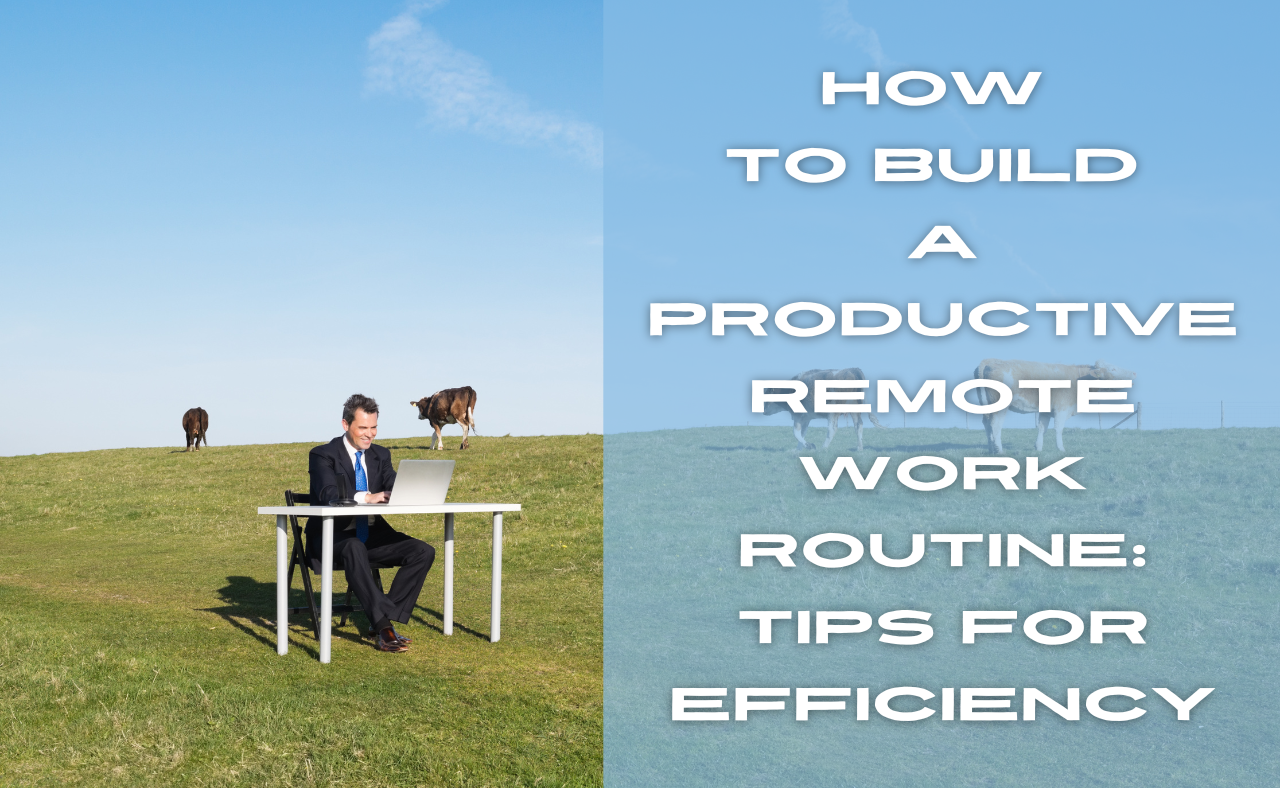Working remotely has become more common, but staying productive outside of a traditional office can be challenging. Without the typical office structure, distractions can quickly derail your focus, and maintaining a balance between work and personal life can be tough.
However, by establishing an effective routine, you can set yourself up for success. Below are actionable tips for building a productive remote work routine to enhance efficiency, boost motivation, and achieve a healthy work-life balance.
1. Create a Dedicated Workspace
Having a specific area where you work each day can help you mentally separate your work from your home life, which is crucial for productivity.
Why It Works:
- A workspace sets the tone that this is a “work zone” and helps reduce distractions.
- It keeps you organized, with all your necessary tools and equipment within reach.
How to Do It:
- Choose a space in your home that is free from distractions (avoid working in bed or on the couch).
- Invest in a comfortable chair and desk to avoid discomfort during long hours of work.
- Add good lighting, a few personal touches, and maintain cleanliness to create an inviting atmosphere.
2. Establish a Morning Routine

The way you start your day can set the tone for how productive you’ll be. A solid morning routine helps you mentally prepare for the day ahead.
Why It Works:
- Having a morning routine helps signal to your brain that the workday is beginning.
- It reduces decision fatigue by establishing a predictable sequence of actions.
How to Do It:
- Wake up at the same time every day: This helps regulate your internal clock and improves focus.
- Avoid checking your phone first thing: Give yourself time to wake up and avoid getting bogged down in notifications.
- Exercise or stretch: Movement can boost energy levels and improve mood.
- Get dressed: Even if you’re working from home, changing into “work clothes” can help shift your mindset.
3. Set Clear Work Hours
One of the advantages of remote work is flexibility, but this can also be a pitfall if not managed properly. Setting regular work hours helps create boundaries and ensures you’re not overworking or underworking.
Why It Works:
- A set schedule establishes boundaries between personal time and work time.
- It prevents burnout by ensuring that you’re not working around the clock.
How to Do It:
- Pick your peak hours: Identify when you’re most productive (morning or afternoon) and schedule deep work during those times.
- Stick to your plan: Be disciplined about starting and stopping at the same time each day.
- Communicate your availability: Let your team or clients know when they can expect you to be online and available.
4. Plan Your Day with a To-Do List
Organizing your tasks is essential for staying on top of your workload. A to-do list helps you prioritize, track progress, and stay focused on what needs to be done.
Why It Works:
- It gives structure to your day and helps you avoid feeling overwhelmed.
- A list helps you focus on one task at a time and provides a sense of accomplishment as you check off items.
How to Do It:
- Start your day with a plan: Spend the first 10–15 minutes mapping out your key priorities.
- Break large tasks into smaller steps: This makes big projects more manageable and less daunting.
- Use productivity tools: Apps like Trello, Asana, or a simple Google Keep note can help you manage and visualize your tasks.
5. Set Boundaries with Family or Housemates

One of the most significant challenges of remote work is managing interruptions from family, roommates, or other household members.
Why It Works:
- Clear boundaries protect your focus and allow you to fully immerse in work without constant interruptions.
- It sets expectations for when you’re available for personal interactions.
How to Do It:
- Communicate your schedule: Let others in the house know when you’ll be working and should not be disturbed.
- Use visual cues: Wearing headphones or closing the door can signal to others that you’re in work mode.
- Designate break times: Inform your household about when you’ll be taking breaks so they know when it’s okay to interact with you.
6. Incorporate Regular Breaks
Taking short, regular breaks can actually boost productivity by preventing burnout and keeping your mind fresh.
Why It Works:
- Breaks prevent mental fatigue, allowing you to return to work with renewed focus and creativity.
- They give your brain time to process information, which can lead to better problem-solving.
How to Do It:
- Follow the Pomodoro Technique: Work for 25 minutes, then take a 5-minute break. After four work sessions, take a longer 15–30-minute break.
- Stretch or go for a walk: Physical movement during breaks can increase energy and reduce stress.
- Avoid using break time to scroll on social media—opt for more refreshing activities like making a cup of tea or stepping outside for fresh air.
7. Minimize Distractions
Distractions can kill productivity. Identifying and eliminating potential distractions is crucial when working remotely.
Why It Works:
- Limiting distractions allows for sustained focus, leading to better quality work and faster completion of tasks.
- It promotes deep work, where you can get into a state of flow and tackle complex problems.
How to Do It:
- Turn off notifications: Silence non-essential notifications on your phone and computer during work hours.
- Use apps to block distracting websites: Tools like Freedom or StayFocusd can block social media or entertainment sites during work hours.
- Create a noise-free environment: Consider using noise-canceling headphones or ambient sound apps like Coffitivity.
8. Prioritize Work-Life Balance
Maintaining a healthy work-life balance is essential to avoid burnout, especially when working from home. Without clear boundaries, it can be easy to let work take over your personal life.
Why It Works:
- A healthy balance keeps you energized, prevents fatigue, and improves overall well-being.
- It ensures you’re able to fully disconnect from work and enjoy personal time, leading to a more sustainable routine.
How to Do It:
- Set an end-of-day ritual: Signal the end of the workday by closing your laptop and tidying your workspace.
- Schedule personal activities: Bookend your work hours with non-work activities such as exercise, hobbies, or family time.
- Use your lunch break: Step away from your desk during lunch and avoid eating while working to ensure you’re taking a real break.
9. Stay Connected with Your Team

Remote work can sometimes feel isolating, especially if you’re used to collaborating in a physical office. Staying connected with your team is crucial for maintaining engagement and avoiding loneliness.
Why It Works:
- Regular communication helps maintain a sense of community and teamwork, improving overall morale and collaboration.
- Staying connected also helps avoid misunderstandings and ensures that work stays on track.
How to Do It:
- Schedule regular check-ins: Have virtual meetings with your team to stay aligned on projects.
- Use communication tools: Apps like Slack, Zoom, or Microsoft Teams can help you stay in touch with colleagues throughout the day.
- Engage in non-work conversations: Take time to chat about non-work topics to build camaraderie, just like you would in a traditional office.
10. Review and Adjust Your Routine Regularly
Building a productive remote work routine is an ongoing process. As your workload and personal life change, it’s essential to review and adjust your routine to ensure it continues to serve you effectively.
Why It Works:
- Periodically assessing your routine allows you to identify what’s working and what needs to be improved.
- It helps you stay flexible and adapt to new challenges or opportunities that arise.
How to Do It:
- Reflect on your productivity: At the end of each week, take 10 minutes to evaluate what helped you stay productive and what caused distractions.
- Tweak your schedule as needed: Adjust your routine based on changes in workload or energy levels.
- Set new goals: Continuously strive for improvement by setting small goals to optimize your work habits.
Final Thoughts
Creating a productive remote work routine takes effort, but with the right structure in place, you can stay efficient, focused, and balanced. By dedicating a workspace, setting clear boundaries, planning your day, and taking regular breaks, you’ll be able to maximize your productivity while maintaining a healthy work-life balance. With these tips, you’ll set yourself up for success, making remote work not only feasible but enjoyable and rewarding.



